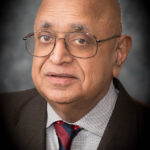Column: This Bothers Me
By Krishnan Chittur

That report completely contradicted the consistent drumbeat in U.S. media about India being the land of muscular religious intolerance. But you won’t find a word about this report in the U.S. media. Surprised?
PEW Research: Meticulous Methods, Impeccable Findings
PEW Research is the pre-eminent research organization in the world in the field of economic and politically consequential information. It conducts empirical research focused on issues underlying most challenging problems. It expertly designs and runs public opinion polls, demographic studies, content analysis, and other data-driven social science research. For decades, PEW has provided factual information based on such intensive research; its reports are routinely relied upon by governments, major institutions, and policy-makers.
PEW’s methodology for this report was incredibly meticulous. To ensure comprehension and cultural appropriateness, PEW followed a multi-phase questionnaire development process with expert review, focus groups, cognitive interviews, pretests, regional pilot surveys, and finally a national survey. It developed the questionnaire in English, which was translated into 16 languages, with the translation independently verified by professional linguists with proficiency in native dialects.
Further, to avoid any skewing of its sampling, it selected respondents using a probability-based sample design permitting robust analysis of all major religious groups and regions in India. It weighted the data to account for different probabilities of selection, and to align with demographic benchmarks from the latest census. The survey was calculated to have covered 98% of Indians over 18, and had an 86% national response rate.
PEW conducted face-to-face interviews between November 2019 and February 2020 of 29,999 adults of all religions in India in 17 languages. Its exhaustive report covered 12 different areas such as religious freedom, discrimination and communal relations, diversity and pluralism, and religious segregation.
What Indians believe as “truly Indian”: Religious tolerance, Respect for All Religions
The PEW Report concluded, “Indians see religious tolerance as a central part of who they are as a nation. Across the major religious groups, most people say it is very important to respect all religions to be ‘truly Indian.’ And tolerance is a religious as well as civic value: Indians are united in the view that respecting other religions is a very important part of what it means to be a member of their own religious community.”
An overwhelming 91% of Indians reported feeling “very free to practise their religion.” Likewise, 84% felt that tolerance, i.e., respecting all religions, is “very important” to being “truly Indian”. An equally respectable 80% felt that respecting other religions is a “very important part of their religious identity.”
PEW documented this commonality in widespread beliefs across religious lines. Thus, 77% of Hindus – and an equal percentage of Muslims – believe in “karma”. A third of Christians believed in the central Hindu tenet, the “purifying power of the Ganges.” A “substantial minority” of Muslims celebrated Diwali and Holi, a Hindu festival. And who doesn’t know that Christmas is one huge celebration all over India, although Christians comprise barely 2.3% of the population. Such cross-religious belief and celebrations are hardly surprising, given centuries of peaceful co-existence of all religions sharing culture and traditions. Indeed, many “religious festivals” should properly be called “cultural festivals”.
Extremely significant, PEW reported, “Relatively few Indians – including members of religious minority communities – perceive religious discrimination as widespread.” So also, contrary to the widely prevalent dogma here, “a majority” of BJP supporters “say religious diversity benefits the country.” Isn’t this incontrovertible empirical evidence newsworthy? But the U.S. media did not – and will not – cover it.
Why The Blackout: U.S. Media’s Confirmatory Bias
The American Psychological Association defines confirmatory bias as “the tendency to look for information that supports, rather than rejects, one’s preconceptions, typically by interpreting evidence to confirm existing beliefs while rejecting or ignoring any conflicting data.” So, U.S. media cover India in a one-sided way to support their pre-existing perceptions, and reject or ignore everything that is contrary to those perceptions.
Hence, the U.S. media covers news reports, big and small, only in terms of what they perceive as Hindu majority, bigotry, and religious intolerance. Most reports are embarrassingly shallow, little more than isolated anecdotes as a pretext for reinforcing these preconceptions.
For example, when a tennis star refused to play in a tournament in India, the N.Y. Times (Feb. 6, 2008) just had to comment about “the rising power of bigotry and intolerance in Indian society” – of 1.38 billion people. Small skirmishes are blown up into headlines (Mar. 4, 2002) screaming India “coming apart at the seams”, and punditry cautioning GOI to “inspire confidence in Muslims and tame militant Hindus.” As if 214 million Indian Muslims constantly live in desperate helplessness, and in fear of savagely truculent Hindus.
Reject or Ignore Everything Contrary to Preconceptions
But this deeply held conviction of “muscular religious intolerance” in India is blown to smithereens by the PEW Report. So, the U.S. media will simply ignore it – it does not fit within their narrative.
Consider the recent empowerment, and the change in status, of Muslim women. The obscurantist Shariat law provisions such as triple “Talaq” – whereunder a Muslim woman could be divorced by the husband saying “talaq” thrice – were banned. This ban was a sea-change in Muslim women’s status, a phenomenal empowerment. As one Muslim woman wrote, “I am an educated Indian woman and I support the government’s stand on the issues of triple talaq and polygamy. . . Muslim women . . have suffered at the hands of Muslim Personal Law Board . .. When I see that India’s defense minister and foreign minister are women, when I see government supporting abolition of nikah halala, polygamy, when I see a bill being introduced in the parliament supporting ban on triple talaq, I feel hopeful that sooner than later we would enjoy the same equality which our contemporaries from other religion enjoy.”
A report about improved status of women – and that too, Muslim women – would run counter to the U.S. media’s inveterate preconception about status of women in India. And their mantra is consistently about “Hindu majority vote,” and transformation of “the constitutionally secular democracy of India into a majoritarian state,” NYTimes (May 18, 2019). So none of this will be covered.
Can We Have Responsible Coverage?
The undercurrent in U.S. media’s coverage is that of India being a land of indefatigable religious intolerance, and bigotry. Until the U.S. media recognizes, and sheds, this confirmatory bias, its coverage of India will continue to reflect pathetic editorial judgment, and continue to be irresponsible.
We expect media to cover newsworthy facts – even if (or especially if) those facts contravene their own deeply held biases. A hitherto unknown comedian’s pathetic rant converting the unfortunate COVID-19 casualties into a “State-Orchestrated Massacre” may feed their toxic pre-existing bias, but do we really expect such outrageous irresponsibility from the highly respected New York Times?
The PEW Report is an important reminder of the fundamental humanity, and basic beliefs in India. We don’t need the U.S. media to tell us that, but it would be good if they just acknowledged it instead of ignoring it while continuing to report provocative and meaningless irrelevancies.
(Krishnan Chittur is a New York-based attorney and community activist, working for international peace and justice)

